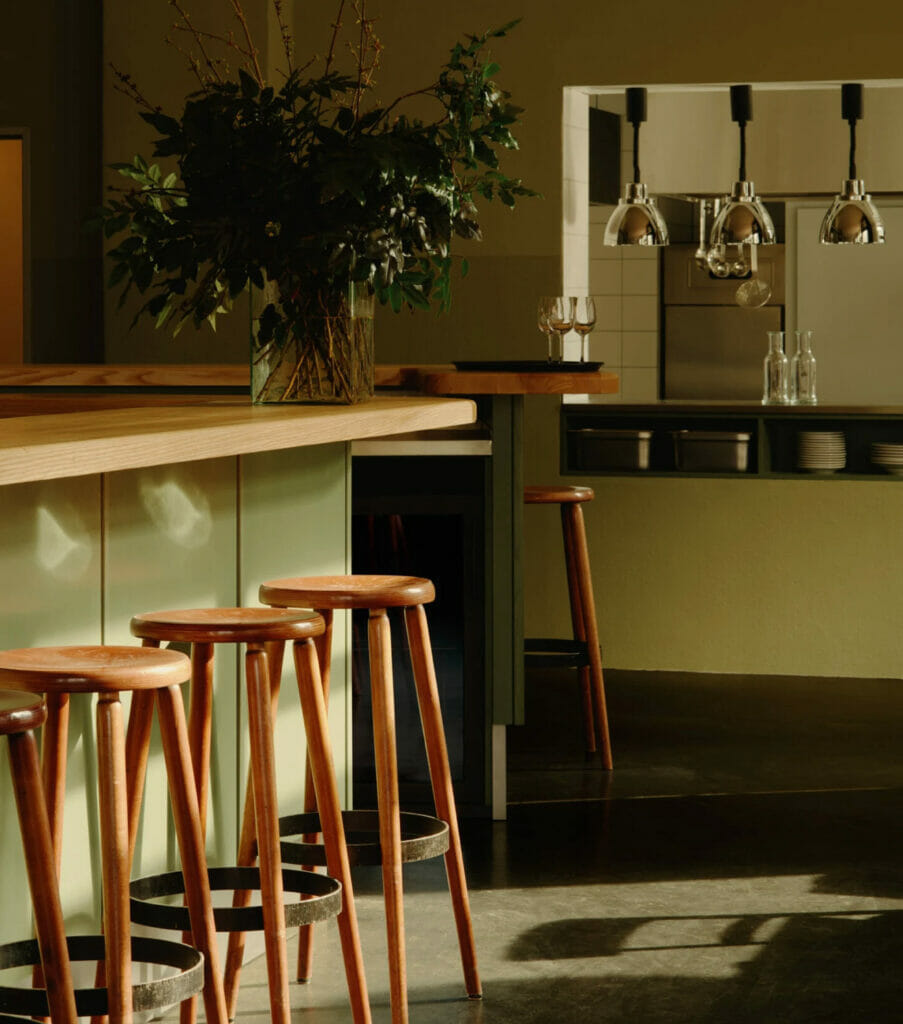
On the opening night of ‘Trio’, a spacious and contemporary new eatery in the Berlin district Mitte, dozens of friends, family members, and passers by are packed into its charming interior, and spilling out onto the street: with glasses of wine in one hand and bowls of goulash in the other. The venue is buzzing with life and energy—a sign of what’s to come—a welcoming place that will serve the Rosa-Luxemburg-Platz square well.

hence its name: Eva Alken, Clemens Roesch, and Vadim Otto Ursus, who worked together for several years in Ursus’ innovative restaurant, otto, in nearby Prenzlauer Berg. “We wanted to create down-to-earth cuisine focusing on regional produce, that is hearty and straightforward,” explains Ursus of Trio’s food concept, “which leaves room for everything else happening around the table.” Alken adds: “We wanted people to be able to come in and sit down and feel instantly comfortable. It is meant to be a vessel for communal gatherings, and a big easy-going space to drop by spontaneously for a glass of wine.”

Trio is the amalgamation of three different backgrounds and upbringings: Roesch, who is from northern Austria; Alken, who is from southwest Germany; and Ursus, a native Berliner. Their disparate regions and relationships with food can be felt throughout the menu, which is an unfussy and approachable collection of generously-sized dishes. Simple pleasures await here: the fish, a crispy whole trout pan fried with hazelnuts and brown butter, or the Austrian-style fried chicken with potato and cucumber salad. Then there’s the Königsberger Klopse, a typical Berlin dish of meatballs in a creamy caper sauce, and the Szegediner goulash with either slow-cooked wild boar or local mushrooms: a satiating Hungarian dish with sauerkraut, served with pillowy-soft knödel dumplings and sour cream.
Other savory plates include mustard eggs and lentil soup, which do well following a portion of Handkäs—a pickled cheese dish that comes from Alken’s hometown. (Many Germans will understand the side of ‘musik’ written on the menu as an obvious in-joke.) “You can’t call it German soul food because that’s not really a thing, but it’s hearty, traditional food made from ingredients that have been around for a very long time,” explains Alken. “We wanted to go back to our origins, and cook the types of meals we knew and loved growing up”Roesch adds: “When you look at the progression of restaurants and food over the last 30 years, so much has changed or been industrialized, and these sorts of meals were leveled down in a way. So we wanted to go back to our origins, and cook the types of meals we knew and loved growing up.”

Where Roesch is from, there is a strong connection to the countryside. “There are many guesthouses serving cuisine that’s like plates of grown-up comfort,” he says. “There’s a certain liveliness to these places, bordering on brutality,” he laughs, “where they get rowdier and rowdier with time.” With a nod to the jovial ‘old-timey’ restaurants they have frequented so many times, the trio hopes that their venue will emulate this energy in its own way. “It’s something you cannot replicate, but it was important for us to have an energetic space that looks to the spirit of those places,” says Alken.
The owners collaborated with Viennese architectural duo Joy Joy Studio on the interior design, where additional decisions were made with carpenters Eric Windel and Jaap Wijnants. The goal was to preserve the strong architectural character of the building and champion its bright and open nature: during the day, natural light floods through the expansive windows, while at night, street light reflects off the warmly lit interior. “There’s many influences on the design, but a big focus is on functionality, so that we can have a lot of seats,” says Ursus. “The carpenters also added so much creatively,” says Alken, “we all shaped the space together as we went along.”
The aesthetics have an inviting feel—a large, asymmetric bar cuts through the center of the dining room, with an ashwood countertop and second-hand wooden bar stools dotted around its perimeter. Black cast-iron tables with red linoleum table tops line the window and raised area behind the counter, where a wooden piano gifted by a family friend sits almost inconspicuously—intended for gentle playing when the atmosphere begins to simmer down. The walls are rendered in shades of green, complemented by industrial, low-hanging lights and ribbed tube-shaped lamps by Berlin-based Hobelsberger Studios. The open-plan kitchen, formerly the test kitchen of otto and before that, a small record store, has a large opening with views into all corners of the space, continuing the literal transparency that has befitted otto so well.

Read more IGNANT
